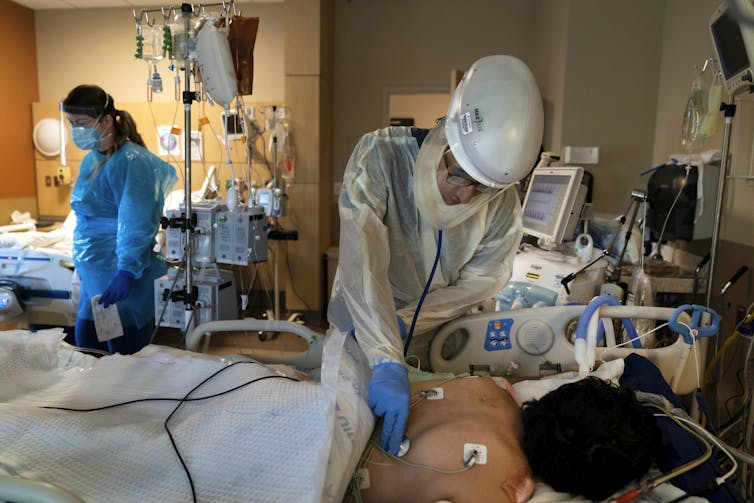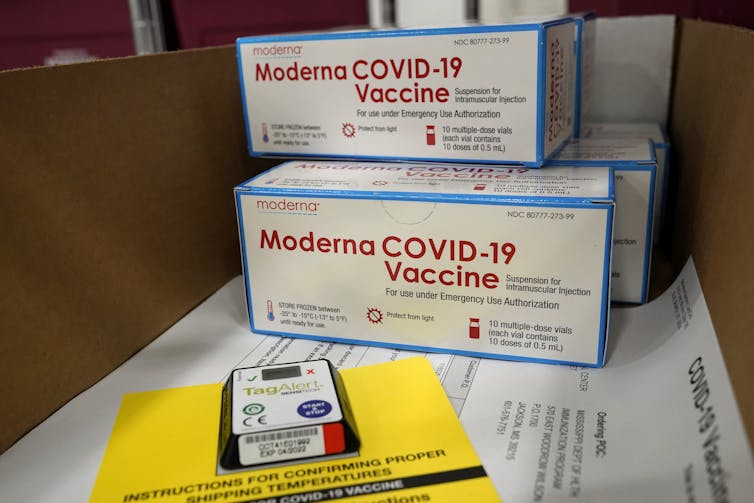US is split between the vaccinated and unvaccinated – and deaths and hospitalizations reflect this divide
- Written by Rodney E. Rohde, Professor of Clinical Laboratory Science, Texas State University
In recent weeks, one piece of data has gotten a lot of attention: 99.5% of all the people dying[1] from COVID-19 in the U.S. are unvaccinated[2].
We are two researchers who work in public health[3] and study immunity[4], viruses and other microbes. Since the start of the pandemic, public health experts have been concerned about what might happen if large sections of the U.S. population, for whatever reason, did not get vaccinated. Over the past few weeks, the answer to that question is starting to emerge[5].
In early July, Anthony Fauci, director of the National Institute of Allergy and Infectious Diseases, warned of ‘two Americas’ emerging.‘Two Americas’ of vaccination
As of mid-July 2021, the U.S. has fully vaccinated more than 160 million people[6] – just under 50% of the population – against COVID-19. Despite a surplus of available vaccines[7], in recent weeks the rate of vaccination has slowed substantially[8]. In early April, health workers administered roughly 4 million new vaccines daily. Today, that number is about 450,000 doses a day.
As people sought vaccines over the past few months, the U.S. has split into what Dr. Anthony Fauci, director of the National Institute of Allergy and Infectious Diseases, is calling “two Americas[9]” – one of the vaccinated population and one of the unvaccinated population. These two Americas are divided geographically and in most cases along political lines[10].
Vaccination rates will continue to rise, albeit slowly[11], as rural areas get better access to vaccines and messaging persuades some vaccine-hesitant people to get the shot. But according to survey data from late June and early July, more than 10% of adults 18 or older say they are probably not or definitely not going to get a coronavirus vaccine[12], with another 5% saying they are unsure. It seems likely there will be a large unvaccinated population for the time being.
 In recent months, nearly every hospitalization or death from COVID-19 has been of an unvaccinated person.
AP Photo/Jae C. Hong[13]
In recent months, nearly every hospitalization or death from COVID-19 has been of an unvaccinated person.
AP Photo/Jae C. Hong[13]
Which America is safer?
The vaccines themselves are nothing short of remarkable in their effectiveness[14] at protecting against COVID-19.
Unvaccinated people, by comparison, are extremely susceptible to the coronavirus, particularly to the delta variant and the data on deaths and hospitalizations show this discrepancy clearly.
On July 16, 2021, Centers for Disease Control and Prevention Director Dr. Rochelle Walensky revealed that 99.5% of recent U.S. deaths[15] from COVID-19 were of unvaccinated people. “Those deaths were preventable with a simple, safe shot,” she said. In Early July, Fauci said that 99.2% of people who died recently were unvaccinated[16]. In the state of Maryland, every patient who died from COVID-19 in June was unvaccinated[17].
In her July 16 statement, Walensky also said that 97% of current COVID-19 hospitalizations are of unvaccinated people. An earlier analysis done by The Associated Press found that 98.9% of all hospitalized COVID-19 patients in May were unvaccinated[18]. The director of the Los Angeles County Department of Health Services recently stated that all new hospitalized COVID-19 patients in Los Angeles were unvaccinated[19].
 In most places across the U.S., vaccines are readily available for anyone who wants one.
AP Photo/Paul Sancya[20]
In most places across the U.S., vaccines are readily available for anyone who wants one.
AP Photo/Paul Sancya[20]
A tale of two states
It is hard to find data about overall cases among unvaccinated compared with vaccinated individuals. This results partly from the CDC’s transition in May 2021[21] to focusing on hospitalizations of COVID-19 vaccine recipients rather than cases. But one way to get at this data is to compare two states with large differences in vaccination rates. As the delta variant of SARS-CoV-2 surges across the U.S., one can observe the consequences of this split into a vaccinated and unvaccinated America in real time.
In the state of Missouri, only 40% of people are vaccinated. In some counties within Missouri, as few as 14.7% of the residents are vaccinated[22]. Not surprisingly, the state has seen a surge in COVID-19 cases through the middle of July, with 2,000 to 3,000 new cases per day[23]. The rate of spread is also increasing[24]. Already, some hospitals are running out of ventilators and intensive care beds[25].
[Understand new developments in science, health and technology, each week. Subscribe to The Conversation’s science newsletter[26].]
Contrast this with Massachusetts, where 63% of people are fully vaccinated. Though the state is also seeing an increase in cases, total new infections numbered only around 200 to 300 per day. The number of patients hospitalized with COVID-19 in Massachussetts is also down 95%[27] since January 2021.
As of July 20, 2021, Missouri[28] had 1,357 patients hospitalized with COVID-19, almost 13 times more than the 106 patients in Massachusetts[29]. This is despite Missouri’s having a slightly smaller population that is much more dispersed.
Does it matter if people stay unvaccinated?
Ultimately, with a large portion of the U.S. population still unvaccinated, COVID-19 is not going to disappear in the near future. The U.S. will continue to see outbreaks of the virus in communities with low vaccine uptake. Even if people in these undervaccinated areas rush to get shots when outbreaks happen, it takes about a month for vaccination to produce strong immunity[30].
As long as SARS-CoV-2 is circulating in the U.S., unvaccinated people will continue to experience the full, dangerous clinical effects of COVID–19. But in addition, while the virus spreads among the unvaccinated, it will also continue spreading at a low level to vaccinated individuals. Though most of those infections will not progress to severe COVID-19, according to the CDC[31], as of mid-July more than 5,000 vaccinated people, mostly over 65 years old, had been hospitalized and 1,000 had died. These numbers are of course sad, but they pale in comparison to hospitalizations and deaths among the unvaccinated population.
The vaccines are doing exactly what they were designed to do: prevent severe COVID-19 with amazing efficiency. With vaccines free and widely available, for most people in the U.S. it is a choice: Do you want to be part of the unvaccinated America or the vaccinated one?
References
- ^ 99.5% of all the people dying (apnews.com)
- ^ are unvaccinated (thehill.com)
- ^ public health (scholar.google.com)
- ^ study immunity (www.med.unc.edu)
- ^ answer to that question is starting to emerge (www.cnn.com)
- ^ more than 160 million people (coronavirus.jhu.edu)
- ^ surplus of available vaccines (www.statnews.com)
- ^ slowed substantially (www.theatlantic.com)
- ^ two Americas (www.nytimes.com)
- ^ geographically and in most cases along political lines (www.webmd.com)
- ^ continue to rise, albeit slowly (www.theatlantic.com)
- ^ probably not or definitely not going to get a coronavirus vaccine (www.census.gov)
- ^ AP Photo/Jae C. Hong (newsroom.ap.org)
- ^ effectiveness (www.cdc.gov)
- ^ revealed that 99.5% of recent U.S. deaths (news.yahoo.com)
- ^ 99.2% of people who died recently were unvaccinated (www.npr.org)
- ^ every patient who died from COVID-19 in June was unvaccinated (www.baltimoresun.com)
- ^ May were unvaccinated (apnews.com)
- ^ all new hospitalized COVID-19 patients in Los Angeles were unvaccinated (abc7.com)
- ^ AP Photo/Paul Sancya (newsroom.ap.org)
- ^ in May 2021 (www.cdc.gov)
- ^ as few as 14.7% of the residents are vaccinated (fox2now.com)
- ^ 2,000 to 3,000 new cases per day (www.nytimes.com)
- ^ is also increasing (covid.cdc.gov)
- ^ out of ventilators and intensive care beds (abcnews.go.com)
- ^ Subscribe to The Conversation’s science newsletter (theconversation.com)
- ^ COVID-19 in Massachussetts is also down 95% (www.mass.gov)
- ^ Missouri (www.stltoday.com)
- ^ Massachusetts (www.mass.gov)
- ^ about a month for vaccination to produce strong immunity (www.doi.org)
- ^ according to the CDC (www.cdc.gov)


















